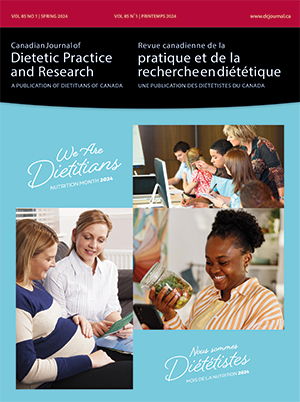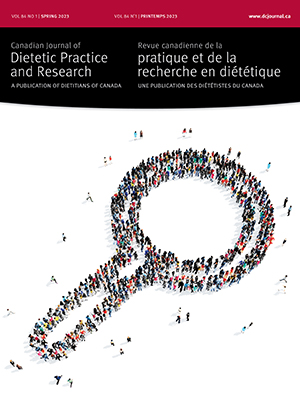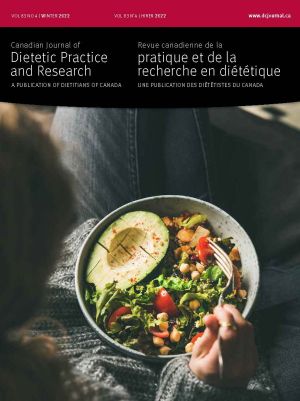Volume 69 • Number 4 • December 2008
Chair’s Message
Editor’s Message
Research
Purpose: The Resident Assessment Instrument–Home Care (RAI-HC) is widely used to assess needs of home care clients and includes five items used to screen for malnutrition. This study involved defining malnutrition risk and identifying other items within the RAI-HC that might improve malnutrition screening among adults aged 65 or older receiving home care. Methods: A literature review, three focus groups of community care access centre case managers (n=29), and five key informant interviews with registered dietitians were used to identify malnutrition risk factors and indicators. A nominal group (n=5) was used to rank RAI-HC malnutrition risk items. Data were charted and integrated to create the final list of potential risk factors. Results: Seven malnutrition indicators (dietary intake, appetite, dysphagia, nutrition support, end-stage disease, weight status, and fluid intake) and seven risk factors (health status, functional ability, self-reported poor health, mood status, social function, cognitive performance, and trade-offs) were considered important concepts in the construct of malnutrition for older home care clients. Conclusions: These items identified through divergent methods form the basis for developing a screening-formalnutrition-risk tool for home care.
Review
Nutrigenomics is concerned with the role of nutrients in gene expression, and nutrigenetics is the study of how genetic variants or polymorphisms (mutations) can affect responses to nutrients; nutritional genomics is the umbrella term. Nutritional genomics can be expected to revolutionize the way dietitians and other health professionals identify people with chronic diseases and treat those diseases. Understanding the science of nutritional genomics is important to dietitians and other health professionals because major scientific advancements such as this usually have a significant impact on ethics, policy, and practice. Blood lipid profiles are one area in which nutritional genomics has quickly advanced knowledge. New knowledge is available on blood lipid profiles and associated conditions, such as obesity and type 2 diabetes. New technology has also had an impact on policy and practice issues, and ethics is an important issue to consider.
Telediabetes is a form of telemedicine used to provide education and clinical care to persons living with diabetes. Web-based delivery modes using cellular telephones and/or computers are of particular interest as they are becoming increasingly available. A review of current research on the practice of web-based telediabetes to adults with type 2 diabetes was conducted to determine the potential impact of this delivery mode on professional dietetics practice. Nine articles meeting the inclusion criteria were identified, critiqued, and summarized. Studies varied greatly in breadth and scope; consequently, few general conclusions could be drawn about telediabetes programs. Telediabetes programs were discussed in the context of soundness, effectiveness, cost-effectiveness, and practical characteristics. Trends indicated a promising future for telediabetes. Dietitians should view telemedicine as a viable tool for service delivery and increase their knowledge, competency, advocacy, and research efforts in this area.
Perspectives in Practice
The increased prevalence of childhood obesity has led to rising rates of type 2 diabetes mellitus (T2DM) in youth. Recommended nutrition strategies for children with T2DM are not well delineated. Adult recommendations for T2DM do not take into account different stages of physical and psychological growth. Nutrition recommendations for children with type 1 diabetes (T1DM) also are not applicable to youth with T2DM, who generally require interventions to promote weight loss. A nutrition education program was developed for youth with T2DM, with attention to current nutrition recommendations and the delivery of nutrition education to obese children, children with T1DM, adults with T2DM, and children with T2DM. Together with program development strategies, a summary of relevant content and mode of delivery is presented for a nutrition education program intended specifically for youth with T2DM at The Hospital for Sick Children.
Report
Purpose: Current prevention-focused nutrition policy for community-dwelling older adults in Canada is discussed. Methods: Government websites were searched and key informants asked to identify relevant documents and policies specific to older adults. These were reviewed to find specific legislation on community nutrition programs for older adults. Results: Despite this population’s known nutritional risk, policies guiding community nutrition programs are extremely limited. Current policies and significant documents and organizations that could influence legislation are acknowledged. Conclusions: Dietitians in diverse settings need to advocate for specific policy concerning preventive nutrition programs for older adults in Canada.
Purpose: An n-3 polyunsaturated fatty acid (PUFA) supplement was incorporated into three food products previously determined to be preferred by cancer patients, and overall acceptability of these foods was evaluated. Methods: Preliminary testing was performed; an internal panel determined initial acceptability of foods with the supplement added. Taste panel evaluations were held at the Cross Cancer Institute in Edmonton, Alberta. Each participant completed a questionnaire rating aroma, flavour, and overall acceptance on a seven-point hedonic scale (1 = dislike extremely, 7 = like extremely), as well as ability to consume each food daily. Results: Foods were well-liked by patients and non-patients. Mean ± standard deviation acceptance scores for the three foods were pasta sauce 5.9 ± 0.94 (n = 90), oatmeal 6.1 ± 0.88 (n = 79), and smoothie 5.9 ± 1.12 (n = 126). Overall, 94% of patients and non-patients gave tomato pasta sauce, oatmeal, and the smoothie an acceptance score of at least 5. Conclusions: The supplement was incorporated successfully into three foods, which were highly accepted by patients with cancer. Further research should focus on incorporating the supplement into flavoured or sweet foods, as these appear most effective. Microencapsulated fish oil in food products may be used as an alternative to fish oil capsules for delivering n-3 PUFA in clinical trials.
Purpose: The relationship between body composition and resting energy expenditure (REE) was investigated in two boys and two men with Duchenne muscular dystrophy (DMD) (ages 11 to 22.4 years) and two boys with Becker muscular dystrophy (BMD) (ages 7.75 and 13.75 years). Methods: The REE was assessed by indirect calorimetry; body composition indices (weight, height, skinfolds, and mid-arm circumference) were measured using standardized techniques and compared with healthy reference data. Results: Those with DMD had reduced corrected mid-upperarm muscle area (C-MUMA) in comparison with healthy peers, and approximately twice the subcutaneous fat levels of subjects with BMD and healthy peers. Boys with BMD had remarkably lower muscle status than did boys with DMD and healthy peers. In both groups, REE was lower than in healthy peers; REE was associated with body weight (r=0.85), height (r=0.92), mid-upper arm fat area (MUFA) (r=0.97), and C-MUMA (r=0.65). Conclusions: Individuals with muscular dystrophy (MD) exhibit considerable disease-specific alterations in body composition. The REE had a stronger relationship with growth (weight and height) and subcutaneous body fat composition and a weaker association with C-MUMA. Understanding the effect of MD on body composition and REE will allow dietitians to individualize energy recommendations.
Purpose: A food frequency questionnaire (FFQ) and an attitude/behaviour questionnaire (ABQ) were developed, and their validity and reliability were tested to determine adolescents’ vegetable and fruit (VF) intakes and factors influencing their food choices. Methods: High school students living in the lower mainland of British Columbia participated. The FFQ was adapted from the National Cancer Institute VF By-Meal screener, which was designed to be used with adults. After several focus groups with adolescents, the FFQ was revised to make it more user-friendly. The ABQ was developed after a literature review of factors influencing youth VF intake, and was based on the constructs within the Health Belief Model. Results: The FFQ was validated against a written 24-hour dietary record (correlation coefficient = 0.52). The test-retest reliability coefficient for the FFQ was 0.46. A panel of experts tested the ABQ construct validity, and changes were made as a result of the recommendations. Internal consistency reliability and test-retest reliability of the ABQ were 0.71 and 0.59, respectively. Both questionnaires were tested for face validity with students and revised accordingly. Conclusions: Further validation of these two questionnaires against other standardized tools is required. Future studies with adolescents using these tools can guide program and resource development.










